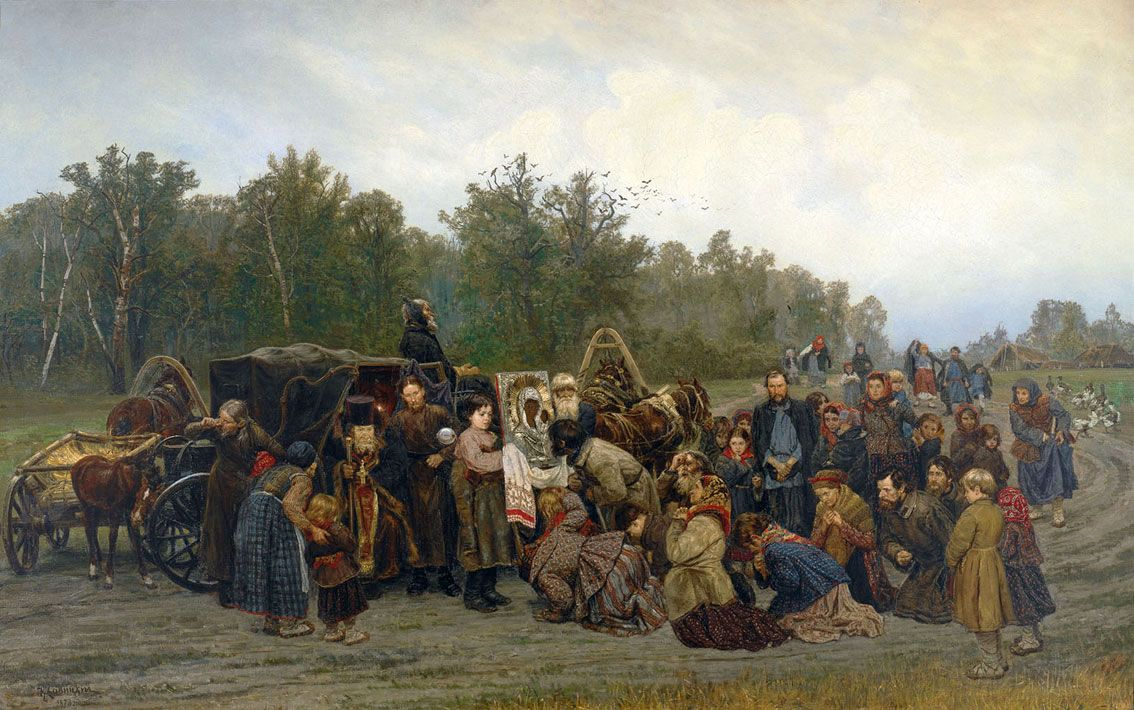log in
Enter site
Login to use Arthive functionality to the maximum
Meeting the icon
Konstantin Apollonovich Savitsky • Painting, 1878, 141×228 cm
Description of the artwork «Meeting the icon»
The artist painted his Meeting the Icon in Dinaburg. Most researchers consider this period the most fruitful in the work of Konstantin Savitsky. According to the critic Vladimir Stasov, Savitsky has a very strong “choral element”. Indeed, he managed to convey the general mood surprisingly reliably. Considering the Russian reality of his day, most often it was national grief, longing, despair, and by no means fun.
The painting became the artist’s response to the events of the Russian-Turkish war of 1877—1878, in which the husband of Savitsky’s sister died, leaving his widow and two small children in his care. The painting was shown at the eighth exhibition of the Itinerants. Stasov began his report of his visit to the exhibition with this work: “Mr. Savitsky unexpectedly brought to the travelling exhibition a painting, albeit small, but excellent, albeit painted in grey, but full of such types and of such truth that make it one of the most significant and important creations of the Russian easel school.” As for the “dirty painting” — many Wanderers were accused of neglecting colour for the sake of didactics. Pavel Tretyakov bought the painting right at the exhibition. Having heard about the dullness of the colour, Savitsky was eager to make changes to the picture, but Tretyakov reacted unfavourably to this idea.
However, the scanty colours made it possible to depict the Central Russian outback fairly reliably: it’s about autumn, the sun is not visible, diffused light breaks through the clouds. The compositional centre of the picture is the icon of the Mother of God — it is the brightest spot, everything else is built around it, it divides those present into two groups: those who brought the icon and those who came to meet it. Attention is drawn to the fact that most of the worshippers are women. Men were at war. It is easy to guess the main prayer of the peasant women was to return their husbands, sons, fathers safe and sound. The figure of a tall man stands out in the crowd of peasants. He stands with folded hands, does not bow, his face is sad. Probably, Savitsky portrayed a once God’s servant in this way.
The Savitsky’s painting echoes the famous work by Ilya Repin, Religious Procession in Kursk Province. However, Repin depicted an encyclopaedia of Russian life, whereas Savitsky was a hailer of the peasantry; it is not for nothing that he was called “the bleeding heart of the people’s grief” and parallelled to Nekrasov ("Nekrasov in Painting"). The Meeting the Icon does not pretend the existentialism of the Repin’s masterpiece, but Savitsky managed to convey the depth of the peasants’ prayers and despair in full measure. In general, Savitsky was not strong in making mythological out of everyday life, rather he used to do the opposite — an excessive humanization of the depicted, which was beneficial to the picture in some cases, but not always. For example, a funny story preceded the creation of the Meeting the Icon. During periods of difficult financial situation in Dinaburg, Savitsky tried to paint icons. But they were not accepted by the Church, since the images of the holy martyrs and the Mother of God looked too much like the artist’s pretty relatives who served models for the painting.
Written by Aliona Grosheva


